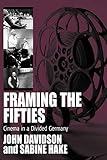Framing the Fifties : Cinema in a Divided Germany / ed. by Sabine Hake, John Davidson.
Material type: TextSeries: Film Europa ; 4Publisher: New York ; Oxford : Berghahn Books, [2007]Copyright date: ©2007Description: 1 online resource (260 p.)Content type:
TextSeries: Film Europa ; 4Publisher: New York ; Oxford : Berghahn Books, [2007]Copyright date: ©2007Description: 1 online resource (260 p.)Content type: - 9781845455361
- 9780857455413
- 791.4/30943 23
- PN1993.5.G3 T35 2010
- online - DeGruyter
| Item type | Current library | Call number | URL | Status | Notes | Barcode | |
|---|---|---|---|---|---|---|---|
 eBook
eBook
|
Biblioteca "Angelicum" Pont. Univ. S.Tommaso d'Aquino Nuvola online | online - DeGruyter (Browse shelf(Opens below)) | Online access | Not for loan (Accesso limitato) | Accesso per gli utenti autorizzati / Access for authorized users | (dgr)9780857455413 |
Frontmatter -- Contents -- Introduction -- 1. The Question of German Guilt and the “German Student”: Politicizing the Postwar University in Kortner’s Der Ruf and von Wangenheim’s Und wieder 48! -- 2. Returning Home: The Orientalist Spectacle of Fritz Lang’s Der Tiger von Eschnapur and Das indische Grabmal -- 3. The Passenger: Ambivalences of National Identity and Masculinity in the Star Persona of Peter van Eyck -- 4. Helmut Käutner’s Epilog: Das Geheimnis der Orplid and the West German Detective Film of the 195 -- 5. Location Heimat: Tracking Refugee Images, from DEFA to the Heimatfilm -- 6. “Great Truths and Minor Truths”: Kurt Maetzig’s Ernst Thälmann Films, the Antifascism Myth, and the Politics of Biography in the German Democratic Republic -- 7. The First DEFA Fairy Tales: Cold War Fantasies of the 1950s -- 8. Visualizing the Enemy: Representations of the “Other Germany” in Documentaries Produced by the FRG and GDR in the 1950s -- 9. The Treatment of the Past: Geza Radvanyi’s Der Arzt von Stalingrad and the West German War Film -- 10. Film und Frau and the Female Spectator of 1950s West German Cinema -- 11. Reterritorializing Enjoyment in the Adenauer Era: Robert A. Stemmle’s Toxi -- 12. Allegories of Management: Norbert Schultze’s Sound Track for Das Mädchen Rosemarie -- 13. The Restructuring of the West German Film Industry in the 1950s -- 14. The Other “German” Cinema -- Works Cited -- Filmography -- Notes on Contributors -- Index
restricted access online access with authorization star
http://purl.org/coar/access_right/c_16ec
The demise of the New German Cinema and the return of popular cinema since the 1990s have led to a renewed interest in the postwar years and the complicated relationship between East and West German cinema in particular. A survey of the 1950s, as offered here for the first time, is therefore long overdue. Moving beyond the contempt for "Papa's Kino" and the nostalgia for the fifties found in much of the existing literature, this anthology explores new uncharted territories, traces hidden connections, discovers unknown treasures, and challenges conventional interpretations. Informed by cultural studies, gender studies, and the study of popular cinema, this anthology offers a more complete account by focusing on popular genres, famous stars, and dominant practices, by taking into account the complicated relationships between East vs. West German, German vs. European, and European vs. American cinemas; and by paying close attention to the economic and political conditions of film production and reception during this little-known period of German film history.
Mode of access: Internet via World Wide Web.
In English.
Description based on online resource; title from PDF title page (publisher's Web site, viewed 25. Jun 2024)


